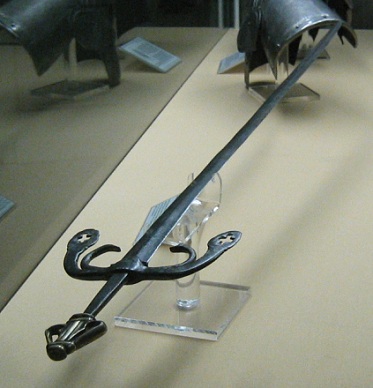Subject: cavaleiro knight
Culture: Portuguese
Setting: Avis dynasty, Iberia / North Africa 15thc
Context (Event Photos, Primary Sources, Secondary Sources, Field Notes)
* Nicolle/Embleton 2012 p13
"The completion of the Portuguese Reconquista, the peace with Castile and the end of Portugal's involvement in the Hundred Years' War had caused something of a crisis for a knightly class whose reason to exist was primarily military. Partly as a result of this, King João I of Portugal -- like his contemporary King Henry V of England -- needed a foreign war to keep his quarrelsome aristocracy occupied, and the chosen target was Sabta (Ceuta), on the Mediterranean coast of Morocco facing Gibraltar. North African adventures were only a partial solution, however, and many young men of high status sought adventure and spiritual and financial reward by joining those pirates who preyed upon Muslim shipping. Such men eventually formed a pool of belligerent manpower, skilled in maritime affairs, from whom Prince Henry the Navigator could recruit crews for longer-distance exploration."
Armor
* Invention of glory 2011 p29 (Donald J La Rocca, "Afonso 'the African' and his army: The Pastrana tapestries as a visual encyclopedia for the study of arms and armor" p29-41) (describing the Pastrana tapestries)
"[Afonso V's armor's] composite nature, consisting of Iberian elements combined with Italian and possibly Flemish export pieces made in the Spanish style, may have been typical of the full plate armor worn by high ranking noblemen in both Spain and Portugal at the time.
Sword
* Norman 1964 p97-98
"Les épées de la Péninsule Ibérique témoignent d'une très forte influence mauresque: les quillons, en forme de coin, sont recoubrés autour des <<bras>> de la poignée, le pommeau en forme de disque plat reste populaire, et la décoration est souvent dans le goût mauresque."
* Invention of glory 2011 p29 (Donald J La Rocca, "Afonso 'the African' and his army: The Pastrana tapestries as a visual encyclopedia for the study of arms and armor" p29-41) (describing the Pastrana tapestries)
"[Afonso V's] sword, held at the ready in his upraised right hand, is closely resembled by two surviving examples preserved in the Royal Armory, Madrid, particularly the sword attributed to Ferdinand II. Equally if not more relevant is its similarity to the hilts on the swords of the king and members of his court in the Panels of St Vincent, painted by Nuno Gonçalves. The salient features that characterize this type of Spanish or Italian sword hilt of the late fifteenth century are the flat disk pommel, symmetrical down curved quillons (the cross guard of the hilt), and the form of the arms of the hilt (the pair of symmetrical semicircular rings) below the quillons on either side of the blade. On the king's sword there is another guard called a side ring, joined to the ends of the arms of the hilt, which on an actual sword would be perpendicular to the plane of the blade. The addition of this small feature is characteristic of the artist responsible for the tapestry cartoons and demonstrates his practice of accurately rendering minute details of the arms and equipment throughout the tapestries. Swords with similar hilts are also worn or wielded by several other figures in the tapestries. Rather than the usual sword belt worn around the waist, as was the norm across Europe, the king and virtually all of his soldiers wear baldrics, suggesting a practice particular to Portugal in this period. The baldric is a belt worn over the right shoulder and diagonally across the torso, the examples here ending in a split strap at the back from which the scabbard hangs at the correct angle. In the tapestries it is cinched in place by a separate waist belt."
Dagger
* Invention of glory 2011 p31 (Donald J La Rocca, "Afonso 'the African' and his army: The Pastrana tapestries as a visual encyclopedia for the study of arms and armor" p29-41) (describing the Pastrana tapestries)
"Many of the foot soldiers have a dagger thrust through the waist belt on the right side or, more frequently, at the back of the right hip. The latter is a placement often seen in works of art of the fifteenth and sixteenth centuries. It positioned the dagger so that it could be drawn quickly by reaching back with the right hand when it was needed for close combat or in the final throes of battle. Roundel and ballock daggers, both typical forms of the period, are among those shown in the tapestries."

